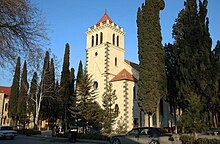|
Shamkir (city)40°49′47″N 46°01′08″E / 40.82972°N 46.01889°E
Shamkir (Azerbaijani: Şəmkir), known historically as Annenfeld, is a city in and the capital of Shamkir District in western Azerbaijan, located in the northern foothills of the Lesser Caucasus, on the coast of the Chagirchay River on Tbilisi-Yevlakh highway, about 4 kilometers (2.5 mi) from Dallar railway station. It is the eighth most populous city in Azerbaijan. EtymologyOne theory is that the name derives from the dialectal Azerbaijani word sham, meaning a place covered in green.[2][3] Population As of October 1, 2021, the population of the region was 221,372 people.[4] History In antiquity, the territory of the modern Shamkir was part of the province of Utik, a part of the Kingdom of Armenia until 387 AD. Greco-Roman historians from the 2nd century BC to the 4th century AD state that Utik was a province of Armenia, with the Kura River separating Armenia and Caucasian Albania.[5][6][7] The historical Shamkur (also known as Shamkhor and Shamkir[2]) has been known since the 5th century as a merchant and craft center of Persia.[3] In 652, the city was seized by Arabs.[8] In 737, Khazars settled in Shamkir after the Arabian commander Mervan's campaign to the Volga.[8] In 752, the city was destroyed by the Sabir people, who lived nearby and rebelled against the Arabs.[8] In 854, the Muslim Khazars took refuge in Shamkir.[8] Later, the city was under the reign of Ganja amirs from the Kurdish dynasty of Shaddadids.[8] In the 12th century and in the beginning of the 13th century, Shamkir was under the Georgian reign.[8] In 1195, the Georgian Queen Tamar's commanders destroyed the troops of Azerbaijan's Atabey Abu-Bakr, who was from Seljuk dynasty of the Ildegizids.[8] In 1235, Shamkir was destroyed by Mongols.[8] From the first quarter of the 16th century till the beginning of the 19th century Shamkir was governed by hereditary rulers a Turkic tribe called Shamsaddinli-Zulgadar.[8] In 1803, during the military actions against the Ganja Khanate of Qajar Iran, Shamkir was taken up by Russian troops and annexed to Russia.[8] In 1817–1818, a colony of Germans resettled from Württemberg, was established on the site of Shamkir under the name Annenfeld.[2] There were also other Germans in Azerbaijan besides those associated with the colony. On September 3, 1826, during the Russo-Persian War, the Shah's guard consisting of 10,000 soldiers was destroyed near Annenfeld.[8] In 1915, Assyrians from Turkey and Iran were resettled here and still lived here as of the 1930s.[9]  Following World War I, Annenfeld was given the Russian name of Annino (Russian: Аннино).[2] In 1938, it was granted urban-type settlement and renamed Shamkhor (Шамхор), after the nearby railway station and the historical Shamkir.[2][3] In 1944, two years after the German population was deported as part of the population transfer in the Soviet Union, it was granted town status.[3] In 1991, the name was changed to Shamkir.[2]  EconomyThere are cognac and wine plants and also a plant of local industry functioning in the city. TransportationPublic transportShamkir has a large urban transport system, mostly managed by the Ministry of Transportation. Sports The city has one professional football team, Shamkir, currently competing in the second-flight of Azerbaijani football, the Azerbaijan First Division.[10] The club has two Azerbaijani league titles. As of 2014, city's home of Shamkir Chess a category 22 event and one of the highest rated tournaments of all time.[11] Notable peopleSome of the city's many prestigious residents include: poets Molla Vali Vidadi and Ahmad Javad, footballers Javid Imamverdiyev, Kalin Stepanyan, and archer Zinyat Valiyeva.
References
Sources
External links
|
||||||||||||||||||||||||||
Portal di Ensiklopedia Dunia






